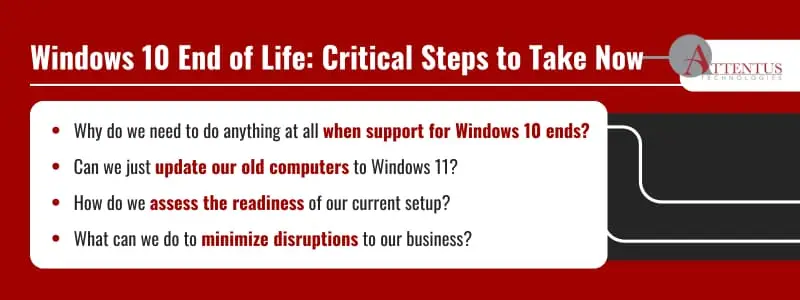The end of support of Windows 10 is fast approaching. What measures should you take now to prevent disruption to your business?

The clock is ticking. Microsoft is stopping its support of Windows 10, Windows 8.1, and Windows 7 on October 14, 2025.
That means no more software updates, technical assistance, or security fixes.
That begs the question: Is it really necessary to make the upgrade to Windows 11?
The short answer is that not doing so increases your risk of falling victim to one of the many cyber threats that keep popping up.
So the real question is, can you really afford to skip the security and other benefits that upgrading to Windows 11 will provide?
Don’t Take Stop-Gap Measures
When planning for an operating system’s end-of-life (EOL), you should know that taking half measures might provide you with only half the benefits and half the protection. Microsoft is offering a $30, year-long Extended Security Update (ESU) for devices, but that will only push the upgrade problem down the road.
It’s better to grab the bull by the horns and do what needs to be done now, before you can saddle yourself with the costs and inefficiencies of running an outdated system.
Assess Your Current Status
The first thing when planning a successful Windows 11 migration is to assess your current setup. Does your hardware meet the requirements for Windows 11? Will your current applications run smoothly on the new OS, or do you need to find alternatives?
There might be ways to update your old systems to Windows 11, but the transition could be problematic and will become even more so with future updates. If you stay with Windows 10, many of the new applications designed for the new operating system might be incompatible with what you have now.
A study by Intel shows businesses spend an average of $427 on repair costs for PCs that are four years old or older, which is 1.3 times higher than the costs for newer PCs, so you’ll likely save money in the long run by making the switch.
That’s especially true when you consider older computers can also:
- Hamper employee productivity
- Have more security vulnerabilities
- Require tons of maintenance
- Run slower than new machines
- Get less support
- Have compatibility issues with new software
Microsoft offers a PC Health Check tool to determine if your existing PCs meet the requirements for the latest update. It will also tell you what you can do if they don’t.
Develop a Clear Plan for Migration
A clear migration plan is key to moving from one device to another.
- Define the scope for migration, including which devices need to be upgraded and prioritized based on business needs.
- Decide how much time you can devote to the migration.
- Determine how to handle the needs of remote users as well as in-house staff.
- Identify which user data you’re migrating and how you will handle this task.
- Determine where you will migrate, whether to a cloud-based environment or alternative operating systems.
- Answer how you will transport user profiles, files, and settings to the new environment, and whether you have the I.T. tools and expertise in place to manage these tasks.
Minimize Disruption to Your Business
Any kind of major migration to a new operating system needs to be handled carefully to prevent costly disruptions to your business. You may want to migrate users in batches or phases to break up the workload and minimize threats to business continuity.
Start with non-critical departments, such as HR or marketing, so you can iron out any problems before moving on to critical business functions.
The process will be smoother if you have already checked for software and hardware compatibility issues, and decided whether you are updating older computers with the new software, or doing clean installs on new machines.
Have a robust data backup and recovery plan in place as well, on the off chance anything goes wrong. Plans should also be put in place to communicate the transition process to all employees, providing the information and training they need to use the new tools of Windows 11 safely and productively.
A Good Managed Services Partner Can Smooth the Transition
It can be overwhelming to handle all the factors involved in making the transition from Windows 10 to Windows 11, but a managed services partner (MSP) like Attentus Technologies can ensure the process is both smooth and secure.
As the I.T. provider of choice in the Pacific Northwest, we have deep experience making critical digital transitions in industry sectors like yours. We are clearly committed to delivering exceptional results, so.
contact us for a free consultation with one of our experts. Turn the Windows 10 end of life into a new beginning with a partner you can trust and rely on.
